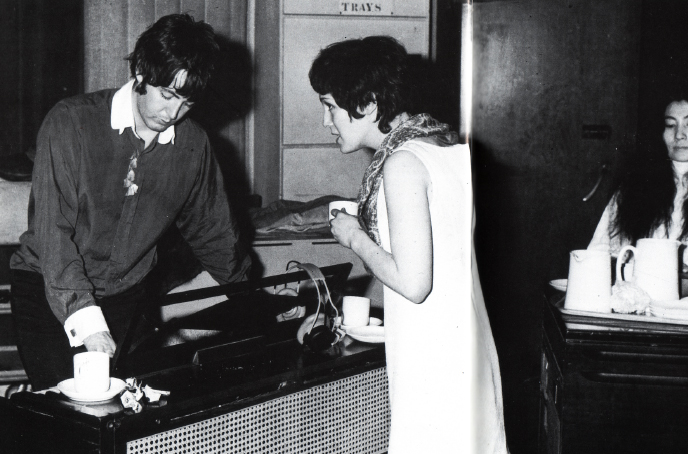From Wikipedia:
On 25 December 1967, McCartney and [Jane] Asher announced their engagement, and she accompanied McCartney to India in February and March 1968. Asher broke off the engagement in the summer of 1968 after coming back from an acting assignment in Bristol to find McCartney in bed with another woman, Francie Schwartz. McCartney and Asher later attempted to mend their relationship, but finally broke up in July 1968. Asher has consistently refused to publicly discuss that part of her life. Schwartz, a twenty-three-year-old New York scriptwriter, had travelled to London to interest Apple Corps in a film script. Schwartz was then asked by McCartney to move into his Cavendish Avenue house, and was given a job working for Derek Taylor at Apple, which was then based in Wigmore Street, London. She attended many sessions during the recording of the White Album, and was living with McCartney when Lennon and Yoko Ono were also invited to live there. Shortly after, Schwartz sold the story of her time at Cavendish Avenue to Rolling Stone magazine.
From mccartney.com:
Intrigued by the Beatles‘ formation of the Apple Corps, which she had read about in the American magazine Rolling Stone, she went to London at the age of 23 to see if one of her scripts was of interest to what she regarded as the “non-establishment“. She met the Beatles at a critical point in their development, when they were making the White Album.
Her script was for a film about a street violinist and actor she had met when he was doing his act in front of Carnegie Hall, New York City. She thought the story would be perfect for Paul McCartney with the addition of his lyrical and romantic musical melodies. She came to London on 3 April 1968 and, a few days later, walked into the reception room of their first office at 95 Wigmore Street. This was prior to Apple Corps’ move to Savile Row later in 1968. McCartney was standing there in conversation with some business contacts. A relationship developed and he later invited her to move in with him at 7 Cavendish Avenue in St John’s Wood, where he was living at the time. McCartney gave her a job working for Derek Taylor, Apple Corps’ Public Relations manager, writing press releases for various Apple Corps artists including James Taylor, Mary Hopkin, Badfinger and Jackie Lomax.
While Jane Asher was away on holiday, Schwartz lived with McCartney. Schwartz says they had nicknames for one another: he was “Mr. Plump” and she was “Clancy”. According to most accounts, Asher returned to find them in bed together. One of the fans who used to hang around McCartney’s house at 7 Cavendish Avenue in St Johns Wood, London, says that “…Paul brought this American girl home…[and a little while later]…another car turned into Cavendish Avenue — it was Jane. She’d come back…earlier than she was supposed to. Jane went into the house. A bit later on she came storming out again and drove away.” Later on, Jane’s mother arrived to retrieve Jane’s things. Schwartz later stated in her book Body Count that McCartney and Asher had broken up before the affair, but she did not deny that Asher saw them in bed together. She insists that Asher “knocked” on the bedroom door first.
The relationship quickly degenerated. McCartney apparently made her leave several times before the final split between the two. Beatles associate Tony Barrow believed that Paul “used her” to break up with Jane.
She was present, as was John Lennon‘s girlfriend Yoko Ono, when the White Album was being recorded. She said, at this time, she “was almost always stoned” and “the four began to diverge as artists during these sessions”. Lennon and Ono came to live at Cavendish Avenue temporarily as guests when Schwartz was living there. Schwartz says that Lennon was upset one morning after McCartney admitted sending a note to Lennon, which referred to Ono as a “Jap tart“, but McCartney insisted that it was intended as a joke.
Francie told the author that she sang in the backup verses of doo-wop on “Revolution 1“. John Lennon also once stated in an interview that the song, “I thought it was about Francie Swartz”
On Sunday, 28 July 1968, in the midst of recording the White Album, the Beatles decided to spend what became known as “A Mad Day Out”, being photographed at seemingly random locations in London. Schwartz had the task of picking suitable photographic sites. War photographer Don McCullin was the primary cameraman, with additional photographers Ronald Fitzgibbon, Stephen Goldblatt, Tom Murray, and Tony Bramwell coming along as well. Beatles’ assistant Mal Evans also took pictures. Ono and Schwartz were also present.[14] In February 2010, Tom Murray unearthed some of the “Mad Day Out” photographs and put them on display at the Three White Walls Gallery in Birmingham, England.

Rule out all those draggy romance rumours which were linking Paul’s name with a temporary Apple employee, an American girl named Francie Schwartz. Francie quit Apple and went home to the USA several weeks ago!
From the Beatles Monthly Book, N°63, October 1968
May 31, 1968 • Songs recorded during this session appear on The Beatles (Mono)

Notice any inaccuracies on this page? Have additional insights or ideas for new content? Or just want to share your thoughts? We value your feedback! Please use the form below to get in touch with us.